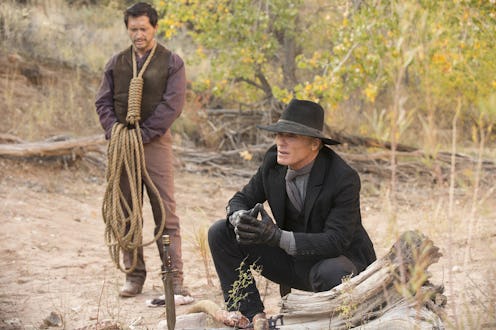
We’re nearly midway through Westworld’s first season, and things are even more mysterious than when the series began. One of the biggest questions thus far revolves around the enigmatic Man In Black and his hunt for the park’s secret, deep-level maze. Speculation about its significance has run rampant since the pilot, but there's one Westworld maze theory that is very convincing and just may hold the key to unlocking the maze's true meaning.
Clever Reddit user PetrusDran noticed an intriguing link between the map the Man In Black scalps from host Kissy’s skull and a motif from real Native American history. Not only do the patterns bare an uncanny resemblance to one another, but the backstory that PetrusDran cites seems to tie up a lot of loose ends. The Reddit user quotes the Wikipedia page for I'itoi, which states that the ancient O’odham design positions the figure of a man at the start of a labyrinth. Each image features a mistake called a “dua,” or door, which is an intentional marking made so that the spirit of the item — often a basket — can be released. This history is also found on River Trading Post and labyrinthina.com, and though the portion about the door cannot be verified elsewhere online, the labyrinth symbol really was a part of O'odham culture, as evidenced by multiple pieces held by the Smithsonian that feature similar designs. The museum also refers to the design as "man in the maze."
A conversation between Bernard and Dolores in the third episode of Westworld seems to reference this concept of the "mistake" door. When Bernard questions Dolores about whether or not he made a “mistake” by letting her begin to remember her previous narratives, he says, “Imagine there are two versions of yourself: one that feels these things and asks these questions, and one that's safe. Which would you rather be?” Dolores insists that there are not two versions of herself, only one, and once she figures out who she is, she’ll be “free.”
Here’s where things get eerie. PetrusDan's theory is that Arnold, Westworld’s co-founder, created the maze as a means for the androids to reach real consciousness. When they uncover the “door” to their liberation, they’ll be as free as their human counterparts. This would explain why in Episode 2, the young girl tells the Man In Black the maze is not for him; he is not a host, and thus its endgame does not apply.
Of course, this is just one piece of Westworld’s puzzle box. Creators Jonathan Nolan and Lisa Joy have done well to keep their plotlines under wraps, and each episode leaves more questions than answers. Still, the O’odham designs seem to remain popular throughout the Southwestern states, where much of Westworld was filmed, so it’s not a stretch to think the producers would have some familiarity with its folklore. Perhaps the symbol that holds so much of Westworld's mystery stems from the history of our own world.
Images: John P. Johnson/HBO, HBO